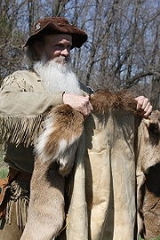
Mountain man
Overview
Exploration
Exploration is the act of searching or traveling around a terrain for the purpose of discovery of resources or information. Exploration occurs in all non-sessile animal species, including humans...
s who roamed the North American Rocky Mountains
Rocky Mountains
The Rocky Mountains are a major mountain range in western North America. The Rocky Mountains stretch more than from the northernmost part of British Columbia, in western Canada, to New Mexico, in the southwestern United States...
from about 1810 through the 1880s (with a peak population in the early 1840s) where they were instrumental in opening up the various Emigrant Trail
Emigrant Trail
The Emigrant Trails were the northern networks of overland wagon trails throughout the American West, used by emigrants from the eastern United States to settle lands west of the Interior Plains during the overland migrations of the mid-19th century...
s (widened into wagon roads) allowing Americans in the east to settle the new territories of the far west by organized wagon train
Wagon train
A wagon train is a group of wagons traveling together. In the American West, individuals traveling across the plains in covered wagons banded together for mutual assistance, as is reflected in numerous films and television programs about the region, such as Audie Murphy's Tumbleweed and Ward Bond...
s traveling over roads explored and in many cases, physically improved by the mountain men and the big fur companies originally to serve the mule train
Mule train
Mule train can refer to:*A connected line of mules*Mule Train, 1949 popular song written by Johnny Lange, Hy Heath, Doc Tommy Scott and Fred Glickman...
based inland fur trade
Fur trade
The fur trade is a worldwide industry dealing in the acquisition and sale of animal fur. Since the establishment of world market for in the early modern period furs of boreal, polar and cold temperate mammalian animals have been the most valued...
.
They arose in a natural geographic and economic expansion driven by the lucrative earnings available in the North American fur trade
North American Fur Trade
The North American fur trade was the industry and activities related to the acquisition, exchange, and sale of animal furs in the North American continent. Indigenous peoples of different regions traded among themselves in the Pre-Columbian Era, but Europeans participated in the trade beginning...
, in the wake of the various 1806–07 published accounts of the Lewis and Clark expedition
Lewis and Clark Expedition
The Lewis and Clark Expedition, or ″Corps of Discovery Expedition" was the first transcontinental expedition to the Pacific Coast by the United States. Commissioned by President Thomas Jefferson and led by two Virginia-born veterans of Indian wars in the Ohio Valley, Meriwether Lewis and William...
s' (1803–1806) findings about the Rockies
Rocky Mountains
The Rocky Mountains are a major mountain range in western North America. The Rocky Mountains stretch more than from the northernmost part of British Columbia, in western Canada, to New Mexico, in the southwestern United States...
and the (ownership disputed) Oregon Country
Oregon Country
The Oregon Country was a predominantly American term referring to a disputed ownership region of the Pacific Northwest of North America. The region was occupied by British and French Canadian fur traders from before 1810, and American settlers from the mid-1830s, with its coastal areas north from...
where they flourished economically for over three decades.
By the time the two new international treaties in early 1846 and early 1848 respectively settled new western coastal territories officially on the United States and spurred a large upsurge in migration, the days of many Mountain men making a good living by fur trapping had become a thing of the past as the industry was a failing subsistence because of over trapping activity vice the lucrative boom business it once been.
Unanswered Questions
Discussions

